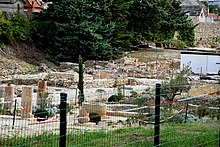Narbonne
| Narbonne | ||
|---|---|---|

|
|
|
| region | Occitania | |
| Department | Aude | |
| Arrondissement | Narbonne | |
| Canton |
Narbonne-1 Narbonne-2 Narbonne-3 |
|
| Community association | Le Grand Narbonne | |
| Coordinates | 43 ° 11 ′ N , 3 ° 0 ′ E | |
| height | 0-285 m | |
| surface | 172.96 km 2 | |
| Residents | 54,700 (January 1, 2017) | |
| Population density | 316 inhabitants / km 2 | |
| Post Code | 11100 | |
| INSEE code | 11262 | |
| Website | Narbonne | |
 Photo montage with buildings in Narbonne . |
||
Narbonne (in Occitan Narbona ) is a southern French municipality with 54,700 inhabitants (as of January 1, 2017) in the Aude department in the Occitania region . Narbonne was the capital of the historical territory of Septimania and was one of the larger cities of the historical province of Languedoc ; today it is the capital of the arrondissement of Narbonne .
location
Narbonne is not far from the Mediterranean coast on the Canal de la Robine at an altitude of approx. 10 m above sea level. d. There is a connection to the Canal du Midi via a connecting canal ( Canal de Jonction ) , which continues the Canal de la Robine inland . Narbonne is connected to the A9 autoroute and the A61 autoroute . The closest major cities are Béziers (approx. 35 km northeast), Perpignan (approx. 65 km south) and Carcassonne (approx. 60 km west). The climate is warm and with little rain.
Population development
| year | 1800 | 1851 | 1901 | 1954 | 1999 | 2013 |
| Residents | 9086 | 13,066 | 28,852 | 32,060 | 46,510 | 52,855 |
The city's population has grown steadily due to immigration from the surrounding countryside.
economy
Narbonne itself was a fishing village for centuries in antiquity and the Middle Ages; Agriculture and viticulture in the surrounding area as well as trade created the basis for the development of the city, which is conveniently located in terms of transport. Today Narbonne forms the framework for small industries as well as for trading and service companies of all kinds. Tourism (Narbonne-Plage) also plays a not insignificant role for the economic development of the city.
history
Narbonne was the first Roman colony outside of Italy . It was made around 118 BC. In what was then Gaul as Colonia Narbo Martius . The Via Domitia , the first Roman road in Gaul, ran through Narbonne and was built around the time the colony was founded and connected Italy with the Spanish colonies. At Narbonne, the Via Domitia connected with the Via Aquitania , which led to the Atlantic Ocean via Toulouse and Bordeaux . The Provincia of southern Gaul was later named Gallia Narbonensis after its capital . As the administrative center of the Roman province, archaeologists have shown that Narbonne flourished economically and housed architectural masterpieces.
After the collapse of the Roman Empire, Narbonne was the capital of the Septimania territory of the Visigoths until the early 8th century . In 719 Narbonne was the first city of the Frankish Empire to be captured by the Moors (→ Islam in France ); 40 years later, it was reconquered by the Frankish King Pippin . In the year 793 Narbonne was destroyed, sacked and depopulated by an army of the emir Hisham I , who resided in Cordoba .
In the High Middle Ages, the Duchy of Narbonne belonged to the sphere of influence of the Counts of Toulouse and thus also the Cathars , who were almost exterminated during the Albigensian Wars (1209–1229). Then the area fell to the French crown . In the years from 1272 to 1332, the Saint-Just cathedral was built in the northern French Gothic style and with a choir apex height of 41 meters is one of the highest in France.
Attractions
- La Cathédrale de Narbonne Saint-Just cathedral : construction began in 1272
- The archaeological museum is housed in the adjacent bishop's palace .
In addition to the cathedral, the Roman remains are particularly worth seeing, including:
- Roman horreum: a granary that was embedded in the ground as a so-called cryptoporticus
- Clos de la Lombarde: Archaeological excavation site with the remains of Roman town houses (" domus" ), the only ones in Gaul. ( http://www.amiscloslombarde.fr/ - website in French and English)
- Remains of Via Domitia : in front of the town hall
- Pont des Marchands : a bridge of houses of Roman origin
- Musée lapidaire de Narbonne, a Roman lapidarium in the former Notre-Dame de Lamourguier church
- Narbonnaise en Méditerranée Regional Nature Park : which also includes parts of the municipality of Narbonne
Personalities
- Saint Sebastian (3rd century), died a Christian martyr in Rome around 288
- Carus (around 223-283), Roman emperor
- Jean-Joseph Cassanéa de Mondonville (1711–1772), violin virtuoso and composer
- Joseph-Martin Cabirol (1799–1874), rubber manufacturer and inventor
- Henry Cros (1840–1907), glass artist, sculptor and painter
- Paul Raynal (1885–1971), playwright
- Benjamin Crémieux (1888–1944), writer
- Joë Bousquet (1897–1950), writer
- Pierre Reverdy (1889–1960), poet
- Charles Trenet (1913–2001), chanson singer, composer, poet and painter
- André Héléna (1919–1972), crime writer
- Jacques Fihey (1931–2017), Bishop of Coutances
- Pedro Soler (* 1938), flamenco guitarist
- Joseph Gonzales (born 1941), boxer
- Joël Prévost (* 1950), chanson singer
- Gérard Schivardi (* 1950), politician
- Éric Andrieu (* 1960), politician
- Alex Antor (* 1979), Andorran ski racer
- Brice Soniano (* 1979), double bass player
- Ethel-Julie Puig-Arjona (* 1981), beach volleyball player
- Dimitri Szarzewski (* 1983), rugby player
- Camille Lacourt (* 1985), swimmer
- Benjamin Lariche (* 1987), racing driver
- Pierre Mortefon (* 1989), windsurfer
- Marion Mortefon (* 1992), windsurfer
- Alex Baron (* 1994), racing car driver
Town twinning
- Grosseto in Italy
- Aosta in Italy
- Salford in Great Britain
- Weilheim in Upper Bavaria ( twin town )
literature
- Rémy Cazals, Daniel Fabre (eds.): Les Audois. Dictionnaire biographique. Association des amis des Archives de l'Aude, et al., Carcassonne 1990, ISBN 2-906442-07-0 .
- Jacques Crémadeills (Ed.): L'Aude. De la préhistoire à nos jours. Bordessoules, Saint-Jean-d'Angély 1989, ISBN 2-903504-24-5 ( L'Histoire par les Documents = Collection Hexagone. L'Histoire par les Documents ).
- Michel Gayraud : Narbonne antique des origines à la fin du IIIe siècle. Boccard, Paris 1981 ( Revue archéologique de Narbonnaise. Supplément 8, ISSN 0153-9124 ).
- Jacques Michaud, André Cabanis (Ed.): Histoire de Narbonne. Private, Paris 2004, ISBN 2-7089-8339-3 .
Web links
- City website (French)
- Le Petit Narbonnais French
- Photos of the city ( Memento from February 25, 2017 in the Internet Archive )
- 3D ancient sculpture from Roman times






